It has rained all day, every day for a week now and the sky has run itself out of water! I stole this break in the rain to check on sown seeds and the herbs and berries.The back half of this box is mixed lettuces and the front left is daikon radishes. The front right is leftover bibb lettuce from a Victory Garden project at my son's school.The tomatoes and peppers are hardened off and ready to be planted in the beds. I have my own saved seed serranos as well as an heirloom yellow pepper this year and for tomatoes I am growing an heirloom grape tomato and trying my first F1 hybrid for a red slicing to improve yield.The blueberries are trying to live up to their names with a hint of purple starting to stand out against the green.The sage flowers have been a favorite of visiting bees but are ready for their spring pruning now.The chives are also sporting lovely dead head flowers and at last they seem to be truly established in my garden.Soggy but smiling!
Read MoreAutumn Recess
Autumn has arrived in North Carolina, bringing with it the final harvest of bell peppers, roma tomatoes and serrano peppers.The herb garden has brushed off the first few light freezes and stands ready to make meals fragrant and savory for months to come. I am confident that the thyme, oregano and sage will over winter well and hope that the french tarragon and parsley will also.Parsley is such a staple of fall and winter dishes that I have more growing on my deck. I have been poaching from the deck parsley for a few weeks thinking that it would not handle the frosts as well, but so far it is also doing wonderfully.In previous years I have repeatedly removed pine needles from the garden beds only to replace it with a different mulch. This year I have come to my senses and am embracing the pine trees taking care of mulching for me.Collards, carrots, cabbage and parsnips are tucked into their naturally (and effortlessly) mulched beds.The fall planting of sugar snap peas has been supplying tender pea shoots and now has peas forming as well.The hydroponic herbs were changed over 10 days ago to the varieties I know and love to cook with and are already doing quite well. I am growing 2 plantings each of my favorite basils and cilantros, 3 of the flat leaf parsley and just for fun I am trying to grow 2 red kales hydroponically.With the Super Bowl and attendant tomato starts almost 2 months away, this cozy, fall garden that is mostly taking care of itself feels like a recess.
Read MoreFired Up For Summer
I know it's a bit early to be thinking about summer and fresh from the garden salsa, but the recipe below for Fire-Roasted (Cherry) Tomato Salsa from the very entertaining Chef John Mitzewich (Food Wishes) sent me back to my garden plan to make sure I plenty of cherry tomatoes started to enjoy this salsa all summer!My favorite recipes to make have at least some portion of the ingredients coming from my own garden and this one definitely fits the bill for being NearlyHomeGrown with cherry tomatoes, cilantro, oregano and serranos substituting for jalapenos as key ingredients.
Starting My Garden Early
While Punxsutawney Phil and the meteorologists work out their differing predictions for the end of winter, growers are already hard at work preparing for spring, summer and fall.January plant starts included cabbage,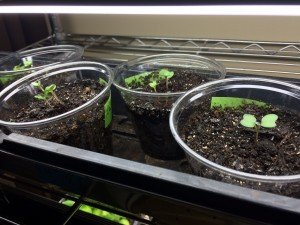 chili peppers, bell peppers and rosemary.
chili peppers, bell peppers and rosemary.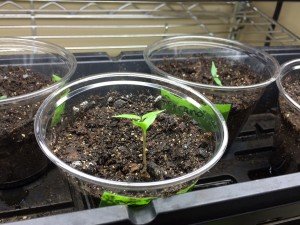 Now that February has begun, the seed starting kicks into high gear with oregano, collards and lots and lots of tomatoes with 8 varieties and a total of 38 plants this year!
Now that February has begun, the seed starting kicks into high gear with oregano, collards and lots and lots of tomatoes with 8 varieties and a total of 38 plants this year!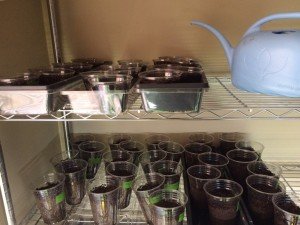 The new starts will welcome roommates in my growing nook for the cilantro and basil I grow indoors each winter. I purchased inexpensive shop lights, metal wire shelving units and florescent tubes 5 years ago so I never have to go a grey winter day without their bright colors and fresh flavors complimenting meals.
The new starts will welcome roommates in my growing nook for the cilantro and basil I grow indoors each winter. I purchased inexpensive shop lights, metal wire shelving units and florescent tubes 5 years ago so I never have to go a grey winter day without their bright colors and fresh flavors complimenting meals.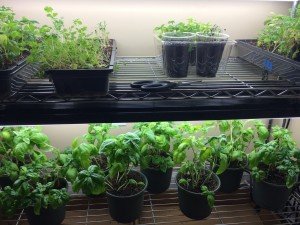 The minimal, initial investment for the equipment has more than paid for itself already and now as my garden diversifies and the number of indoor starts continue to expand each year with no additional infrastructure costs to date, I consider this money extremely well spent.Happy Spring, whenever it comes :)
The minimal, initial investment for the equipment has more than paid for itself already and now as my garden diversifies and the number of indoor starts continue to expand each year with no additional infrastructure costs to date, I consider this money extremely well spent.Happy Spring, whenever it comes :)
The Expat Starter Garden
A dear friend is moving south of the border to live on the shores of Lake Chapala, said to have the second best climate on earth, behind only Atenas, Costa Rica. She wants to start a small garden there and was looking for suggestions.All of these suggestions do very well in both containers (both patio and raised bed) and in rich garden soil, making them versatile, low maintenance choices for a first time gardener.If you are only going to grow one thing, I think basil is a great place to start. It is easy to grow, abundantly productive and can be added to almost every meal you make or have for takeout. I prefer the sweet genovese varieties.If you are only going to grow two things, then basil and cilantro are my choices. Again, easy, abundant and can add a bright taste to any dish, homemade or otherwise. For warmer climates (mine included) try a slo bolt variety.Oregano and rosemary are also low maintenance but useful and abundant herbs for a first time gardener and experienced cook.If she wants to expand beyond herbs, spinach is a great choice for novices. Leaves can be taken as needed allowing the plant to continue growing, many fresh or cooked uses and easy to grow. Again, with warmer climates, a slo bolt variety would be best.After spinach, the chili pepper of your preferred spiciness range. I favor serranos. They are very abundant producers, impart a great flavor in addition to the heat they add to dishes and can be picked green or red depending on your heat preferences. Roasting ripe ones each time you grill and freezing them means delicious roasted peppers on hand year round.And then every gardener's pride and joy, tomatoes. For many of the same reasons, I would recommend cherry type tomatoes for the small scale gardener. They produce much more abundantly than slicing tomato varieties and due to their size can be dried or roasted and frozen for year round additions to meals.With just these 7 items, incorporating bounty fresh from the garden (or preserved from the garden) year round is easy and will work into everyone's favorite dishes.
Quest For Fire
My tomatoes were troopers this year holding onto green romas, blue beauties and red delicious globes into early November, but I gave up and pulled the remainders two weeks ago just so I could begin cleaning the beds and preparing them for winter before heading off to a week's worth of meeting in San Diego last week.This weekend's task was to pull the rest of the serranos off before 3 consecutive nights of freezing or below temperatures hit them. My final harvest ended up being 1lb, 5oz of beautiful peppers that will warm dishes from now until next year. All were cleaned and vaccu-sealed before being frozen except for a few that will go into the Thanksgiving cornbread later this week.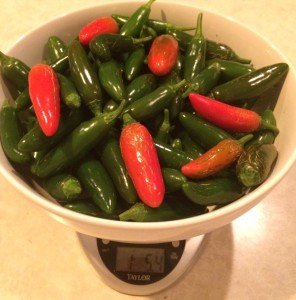 On another pepper note, a friend has some seeds that he will be sharing with me from his home country of El Salvador. I am keenly interested in growing them out next year since he doesn't know the name of them in either his native tongue or English. For now I am thinking of them as Mystery Pepper and what a fun mystery to solve!
On another pepper note, a friend has some seeds that he will be sharing with me from his home country of El Salvador. I am keenly interested in growing them out next year since he doesn't know the name of them in either his native tongue or English. For now I am thinking of them as Mystery Pepper and what a fun mystery to solve!
Variations On A Theme - Potato Leek Soup
My favorite recipes are the ones that resemble a good canvas - a delicious backdrop that can be accentuated and modified by what is in season and/or on hand. Having just finished a post about an overabundance of serrano peppers, I wanted to do a variation on a fall favorite - potato leek soup.This year's leeks are on the thin side which I attribute to my north facing backyard garden, so I harvested roughly 3x the number I would normally use for this recipe.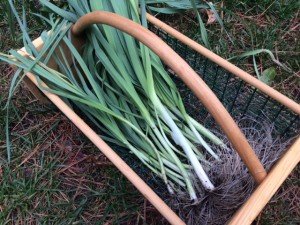
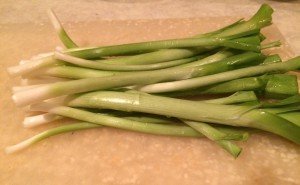 I decided to add some kick to the background canvas and finely chopped 4 roasted red serranos from my freezer and fresh oregano.
I decided to add some kick to the background canvas and finely chopped 4 roasted red serranos from my freezer and fresh oregano.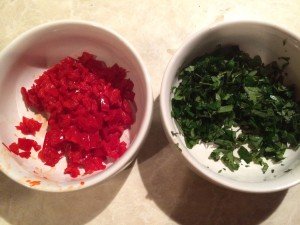
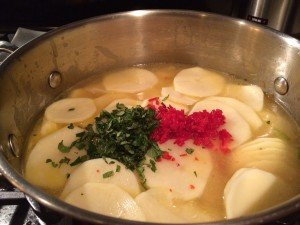 On it's own, this soup is mild but hearty making it a perfect backdrop for any number of flavor profiles.
On it's own, this soup is mild but hearty making it a perfect backdrop for any number of flavor profiles.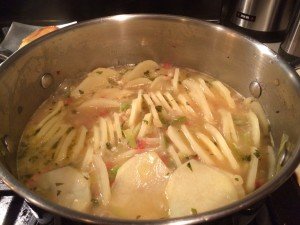 The genius of this soup is the mandolin sliced potatoes.
The genius of this soup is the mandolin sliced potatoes.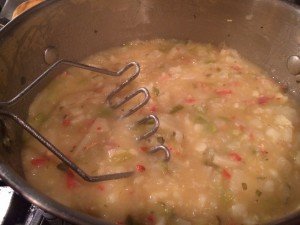 Once cooked through and gently mashed, they thicken the stock and the mashing breaks the potatoes into bite-sized pieces.
Once cooked through and gently mashed, they thicken the stock and the mashing breaks the potatoes into bite-sized pieces.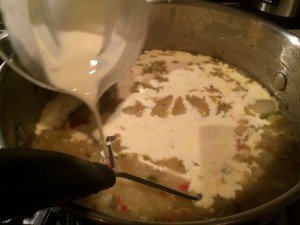 Add a little cream and cook on low for a few more minutes and voila!
Add a little cream and cook on low for a few more minutes and voila!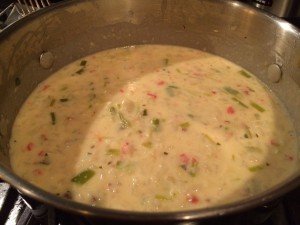 A delicious meal that varies depending on preferences and additions!
A delicious meal that varies depending on preferences and additions!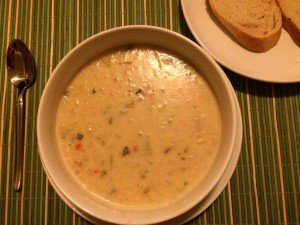
Cooking with Wilbur Scoville
My 3 serrano plants have produced so abundantly this year that even after freezing enough raw and roasted peppers to last until next year's harvest, giving away dozens more to friends and co-workers and drying many more to save seed, I am still drowning in the spicy, delicious peppers.I first learned the distinctive flavor and heat of these peppers back in 2010 after searching and trying one of those 'top secret restaurant recipes revealed' sites for the Chipotle guacamole recipe*. As soon as knife met serrano the unmistakable scent that I associated with Chipotle guac filled the air and I was sold on serranos and I have been growing them since.Serranos are a type of chili pepper that fits on the Scoville scale between between the less spicy jalapenos and the more spicy cayenne peppers. The Scoville chart has its shortcomings, but it is the closest thing to an authoritative ranking of spiciness of chiles that is in culinary use.What I like about serranos is that they have a taste, not just heat, so they add an actual flavor layer to dishes made with them, not just spiciness. I have not been able to find a chart on chili peppers and umami but my taste buds tell me serranos have it.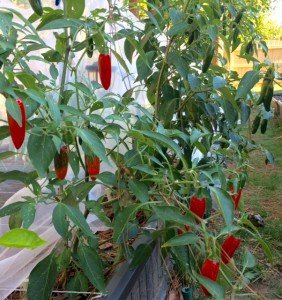 So as much as I love serranos, the still going bumper crop of this year's harvest has presented the challenge of what to do with all of these serranos!Drying ripe, red chiles to save seed made me wonder what the ubiquitous crushed red pepper flakes in my spice jars were made of. A bit of research later and I found that crushed (or dried) red pepper flakes are the result of red chiles, but can be made of a blend or different types and are usually not labeled with the type(s) of chiles inside and are generally blends of several types of peppers.Back in September I decided to gamble some of my over abundance on an experiment and dried about 10 fully red serranos and popped them into the food processor, seeds and all. The seeds are generally believed to convey even more heat to the dishes they are added to than the fruit body so most recipes specify that the seeds should be removed. But the crushed red pepper flakes I have seen always have visible seeds so I left them in.
So as much as I love serranos, the still going bumper crop of this year's harvest has presented the challenge of what to do with all of these serranos!Drying ripe, red chiles to save seed made me wonder what the ubiquitous crushed red pepper flakes in my spice jars were made of. A bit of research later and I found that crushed (or dried) red pepper flakes are the result of red chiles, but can be made of a blend or different types and are usually not labeled with the type(s) of chiles inside and are generally blends of several types of peppers.Back in September I decided to gamble some of my over abundance on an experiment and dried about 10 fully red serranos and popped them into the food processor, seeds and all. The seeds are generally believed to convey even more heat to the dishes they are added to than the fruit body so most recipes specify that the seeds should be removed. But the crushed red pepper flakes I have seen always have visible seeds so I left them in.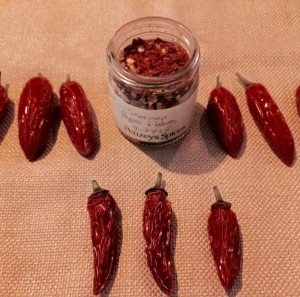 The experiment in making my own crushed red pepper flakes was a huge success! They definitely add the spicy kick that I am accustomed to with the store bought spice and my serrrano-only version is also adding the flavor and body that I associate with serranos.I am drying a second round of serranos to grind into spice mostly because I have to do something with them and I am beginning to think they might make spicy stocking stuffers :)*Interesting side note - the "official" recipe on the Chipotle website calls for jalapenos and is a possible red herring so that the made-at-home version does not taste quite as good as the restaurant version.
The experiment in making my own crushed red pepper flakes was a huge success! They definitely add the spicy kick that I am accustomed to with the store bought spice and my serrrano-only version is also adding the flavor and body that I associate with serranos.I am drying a second round of serranos to grind into spice mostly because I have to do something with them and I am beginning to think they might make spicy stocking stuffers :)*Interesting side note - the "official" recipe on the Chipotle website calls for jalapenos and is a possible red herring so that the made-at-home version does not taste quite as good as the restaurant version.
Fall Garden 2015
As I plan and finish planting my fall garden this weekend I have to give a shout out to the tomatoes, red bell peppers and serrano peppers that don't seem to care that it is the middle of September and are continuing to bloom and set fruit in earnest.Working around these summer hold-overs is a little easier with the addition this weekend of the last two 4-x-4 beds I had planned to add. I have also added 8 1-x-1 boxes that will be used for summer squash next year but are mostly available for planting now.I am trying a non-dwarf variety of collards this fall and trying parsnips for the first time.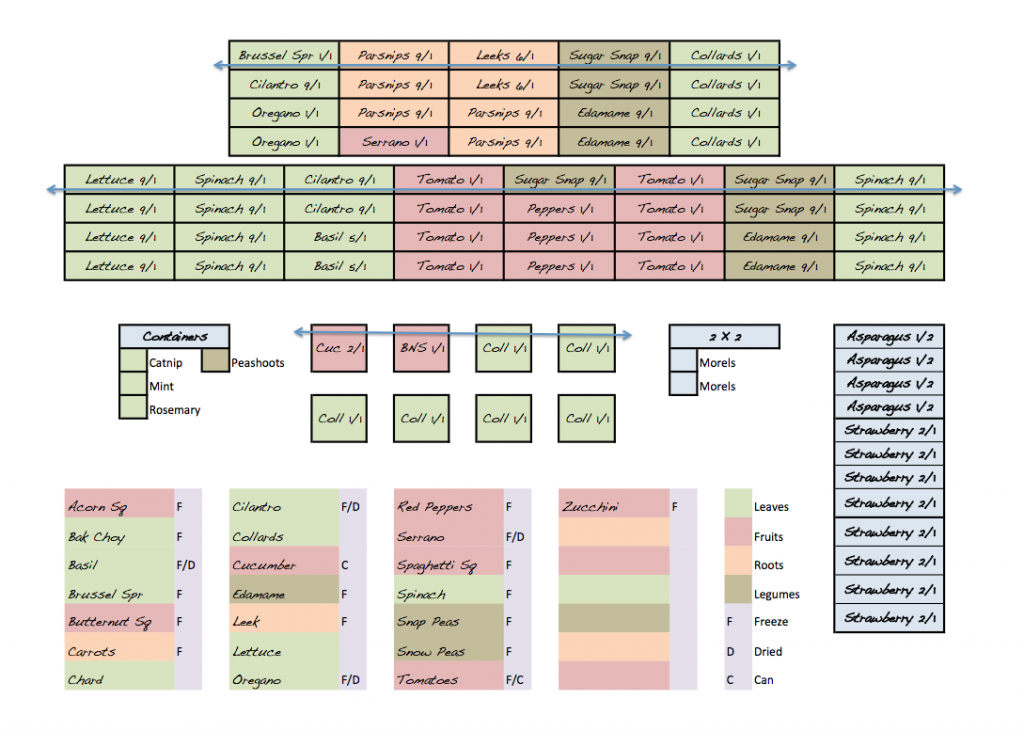 I have added permanent supports along the back portions of beds (blue lines on garden plan) by way of 6' metal fence stakes hung with rungs of coated wire to act as a ladder for climbing plants. It also works well as support for triangle shaped row covers.
I have added permanent supports along the back portions of beds (blue lines on garden plan) by way of 6' metal fence stakes hung with rungs of coated wire to act as a ladder for climbing plants. It also works well as support for triangle shaped row covers.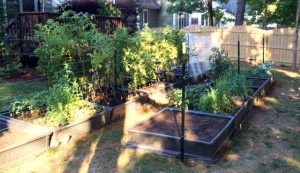 If all goes well I will be serving spinach at Christmas and collards on New Years all fresh from the garden!
If all goes well I will be serving spinach at Christmas and collards on New Years all fresh from the garden!
Seeding the Future
One of my goals for my 2015 garden is to save more seed. Previously I had saved only cilantro/coriander and some flower seeds, but I am turning a corner in 2015 and saving as many seeds from the varieties I grow as possible. The corner of my home office has become the space for drying seeds to be saved for next year's planting.Some of the seeds I am saving are edible as seed, like the Titan Sunflowers I am growing this year in honor of my years in Kansas. These (and the other Titans) will be split between seeds for planting and snacks.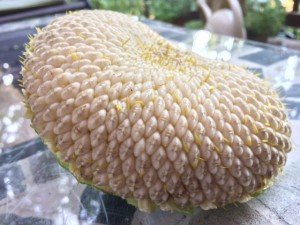 But most are seeds for planting's sake, saving the best and brightest from this year to plan(t) for next year.
But most are seeds for planting's sake, saving the best and brightest from this year to plan(t) for next year.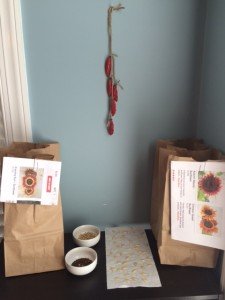 Right now I have some serrano peppers, 3 varieties of sunflowers, spaghetti squash, balsams and candy tufts seeds drying. I will be adding golden acorn squash and oregano to my corner soon.By saving seed from the plants that did best this year, I am selecting those that are most likely to do best in my specific micro-climate again next year, preserving genetic diversity (always a good idea), saving a bit of money in my garden plan for next year and creating a greater level of sustainability for my little acreage and those that want to share in the surplus of seeds.Not a bad way to start the weekend :)
Right now I have some serrano peppers, 3 varieties of sunflowers, spaghetti squash, balsams and candy tufts seeds drying. I will be adding golden acorn squash and oregano to my corner soon.By saving seed from the plants that did best this year, I am selecting those that are most likely to do best in my specific micro-climate again next year, preserving genetic diversity (always a good idea), saving a bit of money in my garden plan for next year and creating a greater level of sustainability for my little acreage and those that want to share in the surplus of seeds.Not a bad way to start the weekend :)
Making Hay While The Sun Shines - Part 2
Even before the surprise bounty of figs arrived on my doorstep Saturday morning, I had a hefty agenda for my first full weekend back home in my garden in 3 weeks.Serranos - picking them at both the green and red stages, sharing some with friends and preserving the rest. My favorite methods for enjoying serranos in the off season are vacuum packing them fresh and whole and freezing or else sliced in half, seeded, roasted on the grill and then vacuum packed.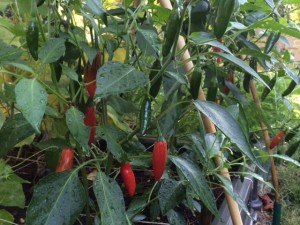
 (roasted, vacuum sealed and frozen)
(roasted, vacuum sealed and frozen)
Cucurbits - I needed to put out 8 new 1'x1' boxes for the fall planting of cucumbers and summer and winter squashes to keep them from shading their neighbors in the garden as well as giving them a bit more room to spread out as well.
 I will be making an A-frame trellis out of bamboo poles and chicken wire this weekend to provide a climbing structure for the back/north-most row that will have cucumbers and spaghetti squash. I am planting 4 varieties of zucchini on the front, south-most row which include 3 new variates in addition to the Black Beauty that have done well despite the invasion of squash vine borers.
I will be making an A-frame trellis out of bamboo poles and chicken wire this weekend to provide a climbing structure for the back/north-most row that will have cucumbers and spaghetti squash. I am planting 4 varieties of zucchini on the front, south-most row which include 3 new variates in addition to the Black Beauty that have done well despite the invasion of squash vine borers.
I also removed the herbs from the middle garden bed in the above shot to make room to double my strawberry patch into a second box for next year with the prolific runners from this year's plants that I have been rooting in containers.
The most handsome specimens of rosemary, sage, parsley and thyme were put into terracotta containers and the rest were dried in the inaugural run of my food dehydrator, crushed and stored in spice jars.
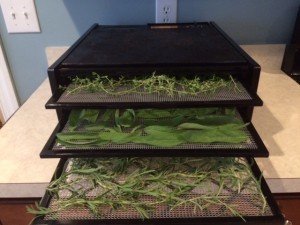 To me, the expression 'making hay while the sun shines' means thinking about where the food on my table in January will come from when I am drowning in the abundance of summer.
To me, the expression 'making hay while the sun shines' means thinking about where the food on my table in January will come from when I am drowning in the abundance of summer.

